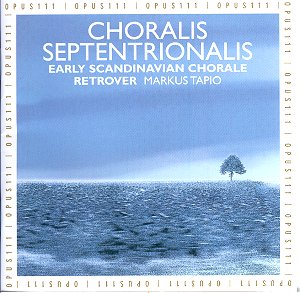 |
CHORALIS SEPTENTRIONALIS: EARLY SCANDINAVIAN HYMS & MOTETS Crotchet AmazonUK AmazonUS Amazon recommendations |
The Retrover Ensemble specialises in the music of the late Middle Ages and Renaissance. Their founder and director Markus Tapio endeavours, the booklet tells us, "to introduce new, unexplored repertoires such as the early music of the Nordic countries" to a new audience. The ensemble consists of five instrumentalists playing organetto, lute, viola da gamba, vielle etc, and six singers including Pia Rask. She has made a special study of the "unwritten polyphonic traditions of the Finno-Ugric people" including, in other words, the music of the far north.
So, the CD consists of music from the very earliest sources, plainchant etc, up to the 16th Century from Finland, Sweden and Denmark. The sources of each piece and each development are clearly given in the booklet. Some of the pieces are in Swedish, French, Latin, some in Finnish and some also in German. The texts are given in the booklet, as are translations into French and English.
The performances are carefully thought out and beautifully executed. The whole concept behind this unique project is clearly stated, however some explanation is needed before you go out and spend hard-earned cash on this unusual CD.
The Finnish choir and their director bring this music to life in various ways. The "pan-European plainchant melody" 'Victimae paschali laudes' (Christians to the Pascal victim) opens the disc. This is sung in Finnish with a homophonic refrain peculiar to its source. We meet this melody again (track 12) sung in French 'O Pasteur d'Israel écoute'. This is first heard in a version for tenor and instrumental ensemble by Claude Goudimel (1514-1572) for two verses, then we hear it more interestingly harmonised without instruments by Claude Le Jeune (1527-1600). Later (track 17), we hear it in a fifteenth century alternatum version by a composer otherwise unknown to me, Johannes Galliculus. The disc ends with a complex version (track 21) by the greatest Danish composer of his time, Mogens Pederson (1585-1623), who features elsewhere on the disc.
Another approach is heard on track 13. Here the traditional Finnish melody for 'Jo heraja Christikunt' (Christendom wake up) is sung unaccompanied for four verses then is followed by an instrumental version of the 16th century, the last verses are then sung over the accompaniment.
A version of 'Christus surrexit' is first heard improvised on the organetto (track 2) followed by a 3-part 14th century version from the Codex Franus. This piece also demonstrates another approach as can be found in track 4. A four-line strophe in the vernacular is given the Greek liturgical acclamation 'Kyrie Eleison'. This approach is known as 'Leisse'. An example of a Leisse is on track 8, where a beautiful Estonian melody 'Nuta inimene' is sung alone and answered by 'Kyrie Eleison, Christe Elesison', in simple four-part harmony.
Some settings are performed by instruments alone, one of them 'Le Commandements de Dieu' on solo lute from Adrian Le Roy's collection I should imagine, of 1572. The great French composer Claudin de Sermisy (c.1490-1562) is also represented by an instrumental version of a popular chanson, which appears in Finnish sources.
Pia Rask demonstrates her skills in the traditional Finnish song known from the Finnish Church hymnal of 1702 but dating back some considerable time before its publication 'Sun tykos turvaan Jumala', 'To you O lord I entrust'. She sings very expressively with a strong understanding of the music and message. She features also on other tracks of traditional melodies for example the astonishingly harmonised traditional melody 'O Christe vapahtajamme' ( O Christ our deliverer) from the same source (track 16). The performance has an upfront strongly folksy flavour, which is most endearing.
To sum up, an interesting CD with some good singing and appropriate and charming instrumental participation. It is well put together and the repertoire is rare and beautiful.
GARY HIGGINSON